CHAPTER VIII - SLIPPING
THE SURLY BONDS OF EARTH
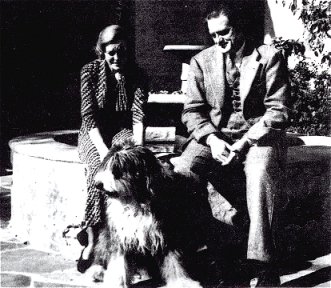
Joan ~ Tarzan, the Sheepdog ~ Jim
Photo by Hulbert Burroughs ~ January 1, 1935
The Burroughs family decided in the late 30s to buy an airplane from
Jim Granger who had a flying school at the old Santa Monica Airport. It
was a side-by-side, single-wing, open cockpit that was not speedy but very
stable and ideal for beginners. I had already started to obtain a private
pilot's license, and was thrilled that Mr. Burroughs became interested.
Both boys, Hulbert and Jack Burroughs, were also taking lessons. Even Mrs.
Burroughs had visions of taking it up.
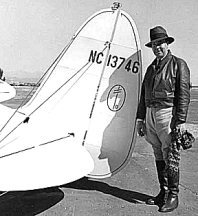 Unfortunately,
Hulbert had a bad crash on a takeoff. He was not seriously injured, but
the event put a damper on the family's flight program. They soon gave it
all up and sold the aircraft.
Unfortunately,
Hulbert had a bad crash on a takeoff. He was not seriously injured, but
the event put a damper on the family's flight program. They soon gave it
all up and sold the aircraft.
I continued flying, and went from a private license to a commercial
ticket. The bug had bitten me good and I needed the extra money to supplement
the lack of income from acting. So I decided to change my hobby into a
business venture. I leased a large hangar at the Van Nuys airport in the
San Fernando Valley, and opened a flying school. Along with the school,
I provided hangar space for several owners of private planes as well as
maintaining a licensed repair station. I secured a dealership for the Interstate
aircraft which became quite popular, and sold several of them. I also bought
and sold used planes.
I had students galore and three full-time instructors teaching like
mad. In 1937, I originated the National Airmen's Reserve, a forerunner
of the Civil Air Patrol The plan was to provide aeronautical training for
civilian pilots, prepare them as a reserve force in case of war, and find
them paying jobs after they completed the course. As I said in a speech
at a service club at the time, "We are not in sympathy with war. We want
to prevent war by building a sufficient defense against it."
The idea was quickly endorsed by the North Hollywood and Van Nuys Chambers
of Commerce, the National Defense League, and publisher Bernard McFadden.
We established our national headquarters at the Adams Port in North Hollywood.
I served as national secretary, with the assistance of Charles McBrien,
head of the charter chapter. The first group of pilots was named the Ken
Maynard Escadrille in honor of the Western star who was as handy with a
plane as with a horse. Incidentally, Mr. Burroughs gave Ken permission
to name his horse Tarzan.
To promote the idea, we started a weekly program on local radio; originally
on KMPC, and later on KFAC. The show featured interviews with guests, like
Maynard and racing pilot, Marion McKeen, who taught me how to fly. American
Airlines stewardess, Wilma Cannon, "Queen of the Airlines," even christened
our first plane.
The show also featured a short aviation serial I wrote and directed,
in which passengers on the Silver Hawk sports monoplane took a goodwill
flight to South America and encountered many dangers. My frequent co-star,
Harold Goodwin, appeared regularly in future roles, along with Jack Leamley
and Joan Allan (Joan Pierce was her real name).
Speaking of Ken Maynard, I would like to mention here that Ken and Kermit
Maynard were as unlike as day and night in life styles and personalities.
Kermit was the quiet reserved type and very athletic. Ken was a rooten
tooten high roller. Every night was SAturday night and his night to howl.
Ken was two or three years older than Kermit and was a top HOllywood
western star when Kermit came to Hollywood. Kermit had to take any kind
of acting job he could find as a stunt man or extra. He bought a horse
and in his spare time taught himself to ride and rope and soon became a
Rodeo attraction as a trick rider and roper.
Although the two brothers were never very close, Ken saw an opportunity
to use Kermit as his double and stunt man. It was not too long before the
western producers saw Kermit as a potential star in his own right. Kermit
had in the meantime won many Rodeo championships in trick riding and roping
including the famous Calgary Stampede in Canada. The result of which put
him in the world championship class.
He was soon signed to a contract to star in his own series of Westerns
and North West Mounted stories. These were successful and being prudent,
he saved his money and prepared for the future. I worked in many of his
pictures and we were fast friends all our Hollywood days. We went all the
way back to our football playing college days. Kermit passed away a few
years ago very suddenly from a heart attack.
Ken died a little later practically penniless, in the motion picture
home, he lived up all his fortune having lost most of it in a Circus
he put together that was a miserable failure. He took it on the road for
a season or two and in spite of pouring a fortune into trying to make a
go of it, it folded. At one time he was one of the richest stars in the
movie business.
Kermit on the other hand left a nice comfortable future for Edith and
his son bill. He had made some sound investments in real estate that left
his wife and son financially secure. His son is now one of the best office
and store interior designers in the area.
In 1941 Joan and I were so sure of financial security that we designed
and engaged a contractor to build us a new home in what is now Sherman
Oaks. It was called Van Nuys in those days. It was about six miles from
Hollywood in the San Fernando Valley.
Spanish design and featured a lot of original ideas. It had the first
knotty pine paneled kitchen in the area. We also had the first used-brick
fireplace and mantle that anybody had seen in that part of the country..
Later on, they became quite popular and used-brick became very expensive.
I got mine just by going down to Los Angeles with a truck and some workmen,
and gathering it up for free from a building being torn down.
In June 1941, we moved into this new house. Business was great and the
change from acting wasn't regretted. Then came December 7, 1941, a day
of infamy in a literal way for me. The government red-flagged every airport
in t eh country and we were closed down. The planes were grounded and the
air reserve project was blown sky-high.
Next day, a federal inspector said I would have to dismantle all the
aircraft, close my business, and store the airplanes (engines in one place,
fuselages in another). We had one other choice, however. We could fly them
out of the prohibited zone of 150 miles from the coast -- within one week.
Luckily, I knew a little strip I had landed on a few times, just east
of Blyth across the Colorado River at Quartzsite. There was one store and
a filling station there, owned by Buck O'Connor. He was a typical "desert
rat," but interested in flying and ran a little ranch in Quartzsite. He
wanted to assist in the war effort, and said I could use his field for
nothing.
I told him I would be over with all the equipment, but there was one
problem. There wasn't any hangar and the planes would deteriorate in
the heat because they were made mostly of fabric.
Fortunately, a fellow named Krafft, who owned a traveling circus was
storing his Beechcraft with me. He was an excellent pilot. He didn't want
to store his airplane and dismantle it, so he offered to send the crew
and one of his tents to Quartzsite to get our planes under cover. Before
the week was out, we had a flying circus of twenty-five airplanes under
the big top. We knew we couldn't stay there long because there was no profit
in desert plane storage.
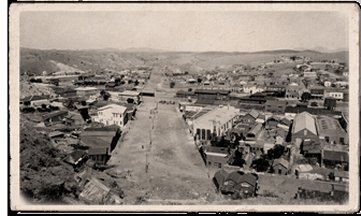 I knew about an
abandoned hangar about four miles out of Nogales, Arizona, which is a gateway
to Mexico. A rich fellow owned a ranch, including this hangar and landing
strip. He had taken up flying as a hobby and intended to run a dude ranch
for flyers. He soon soured on the idea, sold his ranch, and donated this
land and the hangar to Santa Cruz County for an airport. Nothing happened
since Nogales was a small town and there was no interest in flying.
I knew about an
abandoned hangar about four miles out of Nogales, Arizona, which is a gateway
to Mexico. A rich fellow owned a ranch, including this hangar and landing
strip. He had taken up flying as a hobby and intended to run a dude ranch
for flyers. He soon soured on the idea, sold his ranch, and donated this
land and the hangar to Santa Cruz County for an airport. Nothing happened
since Nogales was a small town and there was no interest in flying.
The chairman of the county board of supervisors was Louis Escalada,
a student I knew at Arizona University when I was a coach. He arranged
permission from the supervisors for a lease on the field and the hangar.
We moved quickly from Quartzsite.
A crash program was under way to train badly needed pilots for the war
as fast as possible. I was known in aviation circles, so I as asked to
run a civilian pilot training (CPT) program. I also had an offer to go
into the transport service, flying big cargo planes all over the world.
But that would have meant leaving my family behind which I did not want
to do.
The field was all fixed up with county equipment and workers, who also
cleaned up the hangar. We had our own electric generator to run all of
our tools and equipment. The only use the hangar had seen for several years
was as a hangout for a state hunter. He had a bunch of dogs to hunt the
wolves and coyotes that invaded the ranches.
After the field was fixed up, we got the contract. We had to give these
students thirty-five hours of flying and ground school training, enough
to qualify them for the equivalent of a private pilot's license. We got
permission to use Nogales high school for the ground school. I scrambled
for all the airplanes I could buy or rent, and rounded up twenty-five light
planes. They were the trainer type: Cubs, Tailorcraft, and all kinds of
little "kites" as we called them. They were sufficient for beginning pilot
training.
November 1941 ~ Jim with Travelair with "Comet Engine"
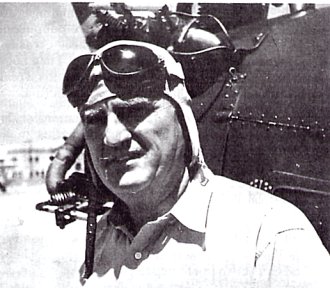 Instructors
weren't hard to find because CPT jobs exempted them from military duty,
and a lot of them didn't want to go to war. For instance, one Jewish fellow
I had known in Van Nuys at my pilot training school said, "I changed my
name because I thought I'd have to go into the regular army as a pilot
and I didn't want to be forced down in Germany with a Jewish name." After
he got the job, he reverted to his original name.
Instructors
weren't hard to find because CPT jobs exempted them from military duty,
and a lot of them didn't want to go to war. For instance, one Jewish fellow
I had known in Van Nuys at my pilot training school said, "I changed my
name because I thought I'd have to go into the regular army as a pilot
and I didn't want to be forced down in Germany with a Jewish name." After
he got the job, he reverted to his original name.
I even had a couple of women instructors, one by the name of Marguerite
Gambo, who brought in ten airplanes from Honolulu. When Pearl Harbor hit,
she was running a successful operation at Hickam Field. She was the daughter
of one of the Dole pineapple people an d used her influence to get permission
to ship her planes to the mainland.
They were dismantled and stored at the Glendale airport with Charley
Babb, a plane broker. He knew I had been looking for planes, so he got
us together and I made a deal to buy them. We sent pilots over to Glendale
and ferried them back to Nogales as fast as we could. At the same time,
I gave her a job as an instructor, and she proved excellent. She had a
four-place Fairchild that we used for profitable charter work out of Nogales.
Nearby, Fort Huachuca had a lot of officers and government men who wanted
to get out occasionally to visit Tucson, Phoenix, or El Paso. I was the
only private operator permitted to fly into this government base.
My credit was good and a banker in Tucson backed the project with all
the money I needed. A senator that my dad and I knew from Indiana, Frederick
Van Nuys, was on the CPT Committee, and got Nogales designated a Class
A International Airport. This gave us room for more students, and planes
from Mexico could land while American planes were cleared for going into
Mexico.
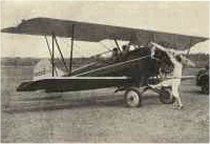 The Pierce Flying
Service was gaining altitude fast, but it almost ended in a tailspin near
Prescott, Arizona in 1943. I was taking delivery of an old Travelair with
a Jacobs engine that was to be sold into Mexico. It had been overhauled
and inspected, and certainly seemed airworthy when I checked it out. During
the night, a cold front brought freezing temperatures and snow to Prescott,
which called itself the mile-high city.
The Pierce Flying
Service was gaining altitude fast, but it almost ended in a tailspin near
Prescott, Arizona in 1943. I was taking delivery of an old Travelair with
a Jacobs engine that was to be sold into Mexico. It had been overhauled
and inspected, and certainly seemed airworthy when I checked it out. During
the night, a cold front brought freezing temperatures and snow to Prescott,
which called itself the mile-high city.
Despite the weather, I took off the next morning with a female pilot
who was to drop me off in Nogales on her way into Mexico to deliver the
plane. After five minutes in the air, the engine began to cough and sputter.
We thought the carburetor heater was engaged, but it had disconnected when
we pulled on the control to activate it. The carburetor was quickly iced
up and the motor conked out.
We climbed only about 1,500 feet and there was total silence, the greatest
and most frightening silence one could ever experience. We were too low
to turn back as all pilots will understand -- turning back toward the field
on a dead engine at this altitude is fatal.
Straight ahead was a lake, called the Dells, filled with jagged rocks
and spires. The only thing to do was glide toward the lake and hope to
land safely in it or along its narrow twenty-five foot shoreline. Unfortunately,
the air was thin at such high altitudes, reducing glide distance. The plane
began to settle fast and we had to fight a stall that would send us into
a fatal tailspin.
Though the pilot had logged lots of air time, she froze in panic. When
she wouldn't release the controls, I socked on the chin and got back on
the glide path. In a few seconds, she came to and began screaming, "We're
going to die, we're going to die!" My assurances that we would make it,
along with the realization that she wasn't flying the plane anymore, calmed
her.
It appeared we were going to reach the lake or the shore. I had already
cut the ignition switch because the tanks were filled with high octane
fuel that could be set off by a spark. No sooner had I sighed with relief
than a huge ditch loomed up. The water flowing into the lake from the surrounding
rocks and mountain had cut a deep gash that looked like the Grand Canyon.
It was too late to change course, I prayed that I could stretch the
glide to pass over the ditch, but the plane would respond no longer. It
stalled out five or six feet short of the ditch. In one bounce, the entire
landing gear and wheels hit the ditch and sheared off. We shot forward
on the plane's belly, to the accompaniment of sparks, smoke, and the most
unearthly noise I ever heard. The woman fainted before we finally slid
to a stop.
I jumped out of the plane, ran around to the left side, even faster
than a golden lion, and dragged her out. I had taken only a couple of steps
back to retrieve the luggage when the plane exploded. The blast knocked
me down, but I managed to scramble for safety and pull the pilot, who was
now awake and screaming again, away from t eh flames and intense heat.
After I calmed her down (without any sock on the chin this time), we watched
the plane burn until only the fuselage frame remained. It resembled the
bones of a huge condor.
Dazed and bewildered, we climbed out of the Dells and trudged through
the snow until we came to a road. Eventually, we were able to hitch a ride
into Prescott. I knew some people there, as I did in almost every town
in Arizona, and they took us in. After a couple of days of filing reports
with the Civil Aeronautics Board and the insurance company while their
representatives examined the wreck, we were flown to Nogales by the operator
of the Prescott airport.
I felt little reaction to the ordeal until a delayed reaction jolted
me a few days later. Then I thanked the Great Pilot in the heavens profusely,
and with good reason. Everyone agreed that the ditch was our salvation.
The terrain along the shore was so rough that it probably would have caused
a fatal cartwheel. The belly landing saved us.
Another experience I will long remember was on a charter flight. I had
an arrangement with the hotels and dud ranches in the area, which were
numerous, to provide charter flights for their patrons whenever needed.
I mad many trips to almost all cities in the south western area. Denver,
El Paso, Alberqueque, Grand Canyon, Salt Lake City, Phoenix, Tucson and
many others too numerous to mention. They ere all routine and profitable.
Nothing exciting ever happened.
However, on one particular day it turned out not to be so routine. The
Casa Grande Hotel in Nogales phoned me for a flight to Phoenix for two
of their guests. The time was set and the hotel limousine arrived at the
field with the two people for the trip. A man and a woman.
As they got out of the car I noticed the man was "bombed" out of his
skull -- drunk as a skunk. He was rubber legged and had to be steadied
by the chauffeur and the woman in order to walk. "Just a minute," I called
out from the door of the office. "Sorry, but the flight is off. I can't
fly an intoxicated passenger -- it's C.A.A. regulations (Civil Aeronautic
Administration) and also against my policy."
The chauffeur sidled up to me and in a sotto voice said, "Do you
know who these people are? It's Mr. and Mrs.. William Freeman of Honolulu.
They own the largest pineapple ranch and packing house in the world."
Mrs. Freeman called out, "Mr. Pierce, I can handle the situation. Trust
me. We have to get to Phoenix as soon as possible."
She was a breath taking beautiful blond and her charm and earnest plea
almost bowled me over.
"Oh please, please," she continued, "I promise there will be no problem."
"Whash a matter - whash a matter, " spoke up Mr. Freeman. "Let's get
out of this one horse town. I wanna drink -- I wanna drink." With that
he pulled a flask out of his pocket and started to open it. Mrs. Freeman
grabbed it out of his hand and gave it to the chauffeur.
With her looks and charm, I figured she really could handle just about
any situation, so I gave in and said, "O.K. We'll give it a go."
We poured him into the plane and off we roared toward Phoenix in a Waco
QDC, 4-place plane with a 350 horse power Jacobs engine.
In about fifteen minutes we had more or less settled down. Mr. and Mrs.
Freeman were in the back seat. I was hoping he would pass out, but no such
luck. He kept yakking for a drink. "There isn't any. You will have to wait
till we get to Phoenix."
"Well, I'll have a cigarette then and no one is going to stop me," he
yelled.
He reached in his pocket for the pack and Mrs. Freeman grabbed his arm.
All Hell broke loose. He started mauling her around and calling us all
kinds of vile names. He made a pass or two at me that I managed to duck.
"Could I light a cigarette and hold it for him?" she asked in a pleading
voice. "I will hold it and he can have a few puffs.
By now he was really violent.
"O.K. - O.K.," I yelled. "Let him smoke but be careful. This plane is
covered with inflammable fabric and a spark could blow us to kingdom come."
Very carefully, Mrs. Freeman lighted a cigarette and held it to his
mouth while he took several puffs. Suddenly he decided he did not like
this spoon fed smoke and grabbed for the cigarette. In the scuffle the
cigarette flew out of her hand as she screamed, "Oh my God, it's behind
the seat," she cried out.
"Unbuckle your seat belt and turn around and see if you can find it
and hurry," I said.
After a few seconds she called out, "I can't see it -- I can't find
it." She was now almost hysterical.
"Fasten your belt. We are going down for a landing and fast," I yelled.
Craning my neck in all directions I suddenly spotted the Air Force Base
at Chandler. Dead ahead about five miles away.
"Here we go," I yelled and like a dive bomber I headed for the field.
I had no radio for permission to land and had to take the chance on
being arrested for landing on an Armed Base in wartime without a permit.
Military planes were ducking and dodging me on all sides. I picked the
runway closest to me and plopped won, down wind yet. Slammed on the brakes,
jumped out and pulled the passengers as though they were two sacks of wheat.
By now Military Police jeeps and fire engines were coming at us with
sirens blasting. When they arrived, I explained our predicament and received
kindly treatment immediately. We observed the plane from a distance for
a few minutes and nothing seemed to be happening. No smoke or anything
unusual.
I told them that I would like to go aboard the plane and find the cigarette
if possible. They assured me they would keep the chemical hoses trained
on the plane as I climbed aboard. I scrounged around behind the seat and
found the half-smoked cigarette. Evidently the hassle of trying to get
the cigarette away from Mrs. Freeman had knocked the burning ashes off
the cigarette and there was nothing left to smoulder. I showed the stub
to the fireman and the MPs to assure them that it was indeed an emergency.
The excitement more or less sobered up Mr. Freeman. The MPs took my
passengers to their office to make out a report. I taxied the plane to
a parking area. After some time of questions and answers for the report
we were released and given a clearance to take off for Phoenix which was
just a few minutes away.
Landing safely in Phoenix did not end my problem with the passengers.
When I read my flight time meter (stool pigeon) and told them the amount
they owed me, Mr. Freeman said he did not have any money on him. Mrs. Freeman
only had a few dollars, not nearly enough to pay the bill. Freeman said
he would send me a check.
"No dice," I said and turned the meter back on. "I'll just wait till
you come up with cash and you figure out how you are going to do it."
I had their luggage locked up in the baggage compartment.
"When I get the cash, you may have your luggage." As the Chinese laundry
man would have said, "No tickee - No washee."'
They called a cab and said they would go to their hotel, get the money,
and come back.
IN about an hour an assistant manager from the hotel returned with the
cash to pay off. I gave him their bags and he went on his merry way.
I immediately slipped the surly bonds of earth and headed for Nogales.
A feeling of peace swept over me as the flickering lights of Phoenix and
the silhouette of the beautiful Camel Back mountain faded into the darkness
behind me.
Raising my head I peered into the untrespassed sanctity of the Heavens
and said, "Thank you Lord."
Foot note: Years later, this most beautiful and charming lady divorced
Mr. Freeman, which is an anonymous name, and married one of Hollywood's
most famous actors.
Early in my Nogales venture, Joan rented our new home in Sherman Oaks
and she and the children came to Nogales for the duration. I rented the
best furnished house I could find, but it was a dump compared to what they
had just left. Nogales was an architectural hodgepodge, built on hillsides,
but a well-run town, made up of about half Mexicans and half Americans.
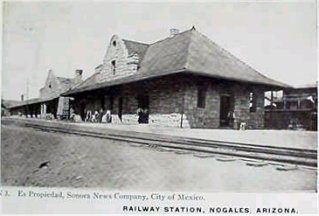 After a hard trip,
Joan, Mike, and Joanne arrived on the train they called the "Burro." It
took about two hours to get from Tucson, but something had happened to
make them two hours late. I could see by their reactions that they thought
they had arrived in the middle of nowhere. This railroad, which ran deep
into the interior of Mexico, was the type Pancho Villa might ahve hauled
his troops on during the Mexican Revolution. I remember that someone once
remarked as the "Burro" was coming out of Mexico, "Holy smoke! What happened
to Burro? It's on time today." It turned out exactly a day late.
After a hard trip,
Joan, Mike, and Joanne arrived on the train they called the "Burro." It
took about two hours to get from Tucson, but something had happened to
make them two hours late. I could see by their reactions that they thought
they had arrived in the middle of nowhere. This railroad, which ran deep
into the interior of Mexico, was the type Pancho Villa might ahve hauled
his troops on during the Mexican Revolution. I remember that someone once
remarked as the "Burro" was coming out of Mexico, "Holy smoke! What happened
to Burro? It's on time today." It turned out exactly a day late.
Even though we were together as a family, it did not work out. Even
the school frightened the children because most of the pupils were bilingual
and they weren't used to hearing Spanish. After two or three months, they
asked to go back to California. Mrs. Burroughs had a big home in Bel Air,
so they went to live with her. Any arrangement was better than having them
miserable.
Soon after their move to Bel Air, Mrs. Burroughs had a serious accident.
A bad fall resulted in a skull injury and a brain hemorrhage. Everything
was done to save her but she lived only a short time afterward. Joan was
with her at the time and it took a long while for her to recover from the
experience as Mrs. Burroughs was always a stabilizing influence. On birthdays,
Christmas, Thanksgiving, and other family get-togethers, she went all out
with wonderful presents and great meals. We all adored her because she
tried to help and council.
We couldn't get our house back because the Office of Price Administration
clamped a lid on everything. The tenants had a right to stay until the
war was over. I checked into a hotel in Nogales for the duration. I was
so busy that it didn't matter much where I lived except that I missed the
ones I loved.
I was the first on the field in the morning and the last to leave at
night, except for the security guard appointed by the FBI. He was also
a deputy sheriff, and I as appointed deputy, too.
The program ran smoothly without accidents or fatalities, and we ground
out pilots until 1945. Cadets who failed as pilots went on went on to become
navigators and aerial gunners.
When the war ended, I didn't try to make it in the private flying business
there because Nogales was such a small town. I sold all the surplus planes
to private operators in Arizona, California, or Mexico. I could have gotten
out of the lease, which stipulated it was for the duration of the war,
but I wanted to help the county get a new tenant and use this fine field
in peacetime.
Luckily, a fellow from New York bought a large abandoned hotel building
two miles from our field. It was spacious, and needed only some renovation.
The original organization went bankrupt, and the idea of a huge resort
and vacation spot, called "Rancho Grande," had flopped. This chap was a
wealthy businessman who owned a chain of dress shop franchises in key cities.
He was also a pilot, though not a good one, and owned his own four-place
Waco.
Like the fellow before him, he had visions of a fly-in dude ranch. We
negotiated successfully with a condition that I stay on to manage the airport
and live in his hotel for six months. He was a hard man to work for. The
business at the hotel was not what he expected, and the airport wasn't
doing much either, so he was full of sour grapes about the whole project.
He wanted to fly a lot and took me with him all over the country, along
with his very young wife and a large boxer dog that was nervous and ran
all over the plane. His plane had a "throw over" wheel which could be passed
from the left to right side of the cockpit. It was not exactly a dual control,
but more like a control and a half. I had only rudders and instruments
on my side. This didn't make me feel very comfortable, though occasionally
he would pass the wheel to me. He insisted on doing all the takeoffs and
landings, and staggered around on both. My eyes were popping out and my
hair standing on end most of these occasions. He yelled at me as though
I were his slave. I had hoped he would fire me, but I was stuck for six
months. I really rejoiced when I could finally return to California.
Meanwhile, my family had returned to our house, but not as soon as they
had wanted. The mother of the tenant had a terminal disease, and she pleaded
hardship to the court when we served the eviction notice. The lease had
run out but the court held in their favor, so we could not get back into
it until she finally passed on.
I was well-heeled, financially, but on the horns of a new dilemma. I
was supposed to get my old lease back on the Van Nuys Airport after the
war, but Lockheed had taken over the field under government supervision
to convert a flock of Army and Navy cargo planes to commercial use. I couldn't
tackle Lockheed, and there were no other desirable places in the area to
open up a flying service.
Hollywood was my first thought. I still had my Guild cards, both my
Class A actor card, and the miserable extra card. After a few weeks, I
managed to scramble up a few jobs from old friends, some speaking parts,
and one or two screen credit roles on Poverty Row. But it was soon evident
that tI was drifting back into the old heartbreak pattern.
Real estate was booming and I knew a few people in the business that
were making it big -- some of them former actors. After a night course
at North Hollywood High school, I took the state board examination and
passed. I was now a licensed real estate broker.
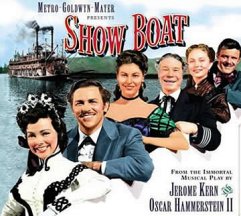 First I took one
more acting job, a part in Showboat
with Howard Keel, Ava Gardner, and Kathrine Grayson. I had a good bit in
it as a doorman. Most of it was cut in final editing, but some of the dialogue
remained. Hollywood might keep rolling along, just like the film's "Old
Man River," but I was now content to stay on the shore -- and sell it.
First I took one
more acting job, a part in Showboat
with Howard Keel, Ava Gardner, and Kathrine Grayson. I had a good bit in
it as a doorman. Most of it was cut in final editing, but some of the dialogue
remained. Hollywood might keep rolling along, just like the film's "Old
Man River," but I was now content to stay on the shore -- and sell it.
I immediately went to work for David Franzen, an acquaintance who was
happy to help me get some practical experience. His office was just two
blocks from our home. I bought a nice new Buick sedan to show prospects
around. I seemed to have a feel for the business and started out making
good sales.
Within six months, I decided to hack it alone, and rented an office
on Riverside Drive in Sherman Oaks. Soon I outgrew this cubbyhole, moved
to larger quarters in Northridge, where things were also booming, and took
on two salesmen.
Next, I was offered the sales agency of a huge tract being built in
Sacramento by Paul Trousdale, who became one of the largest developers
in Southern California and Hawaii. I kept my San Fernando Valley office
going and went to "Sacto," as we called it, to take on this gargantuan
task of selling 1,500 homes as fast as they were built. We sold one hundred
homes a month on an average at eleven to fifteen thousand dollars each
-- many to GIs exercising their housing rights.
Joan would drive up to Sacramento to visit me since I could never get
home once the job started. We went full steam seven days a week, but it
was Fat City, financially. When it was wrapped up, there was no question
that I had found my real calling -- selling real estate.
I kept one airplane and used it extensively to take aerial pictures
of property and land that I had listed. Customers were thrilled to fly
over property they were interested in. I also knew a photographer who wanted
to get in to the aerial business. I flew him to get pictures on orders
he had, and he, in turn flew me to take pictures of property I had for
sale.
My show business contacts were of some help to me as a realtor. For
example, Buster Keaton asked me to find him a home in the Valley. I was
then on the San Fernando Valley Realty Board, with access to all the good
buys. I came up with two or three places I though he might like, and he
bought the first one I showed him. It was about a year old, spacious and
on two acres of walnut grove land. It had several nice out-buildings --
a large barn, a tool house, and a workshop. The original builder had split
up with his wife and the place was sold at a bargain.
At that time, Buster was on his way to a comeback after a long slump
in his career. The estate was well kept and he got interested in farming
the place. He bought some machinery and became a good do-it-yourself farmer,
with the aid of his ever-present Saint Bernard dog, Elmer. He had four
Elmers over the years.)
He liked bridge and poker, and one could get a card game there at the
drop of a hat. He had a miniature train rigged up from the kitchen with
tracks running up, over and around the rooms from the kitchen to the den.
He would send it off with a message in the engine cab for the cook for
sandwiches or beer. It was quite a kick to hear the little train huffing,
puffing, and whistling its way to the kitchen.
Buster became interested in real estate as an investment, and I scouted
up several pieces of property for him that paid off handsomely. He was
interested in land and old homes that could be refurbished and rented.
He would drop into my office occasionally just to find out what was going
on in the Valley, and talk sports, especially baseball.


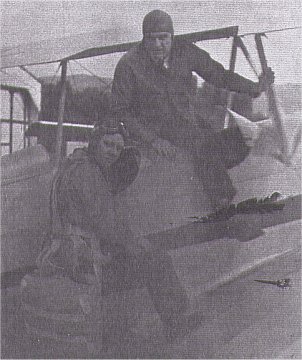
![]()
![]()
![]()
![]()

![]()